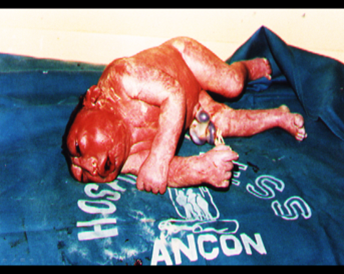ConGENITAL MALFORMATIONS
www.microbiome-autism.com
INVESTIGATING THE LINK BETWEEN ENVIRONMENTAL CONTAMINATION AND 250 CASES OF CONGENITAL MALFORMATIONS AT THE PENINSULA OF SANTA ELENA, ECUADOR - A CASE STUDY
Diego R. Alejandro*, Christian Alcivar, Acacia Alcivar-Warren, DVM, PhD
Fundacion para la Conservacion de la Biodiversidad Acuatica y Terrestre de Ecuador (FUCOBI), Guayaquil, Ecuador; E-mail: [email protected]
Fundacion para la Conservacion de la Biodiversidad Acuatica y Terrestre de Ecuador (FUCOBI), Guayaquil, Ecuador; E-mail: [email protected]
A high incidence of children with Anencephaly has been observed since 1987 in Santa Elena Peninsula of Ecuador.1 Anencephaly, a neural tube defect (NTD), is a malformation characterized by partial or complete absence of the cerebral hemispheres and skull lying above. In some cases, the pituitary gland is also missing or hypoplasia. NTDs are one of the most common birth defects, occurring in approximately 1 in 1,000 live births in the United States, and there is no cure or treatment. It is strongly suspected that anencephaly and other NTDs are due to a combination of multiple genetic and environmental factors. Analyses of placental concentrations of polycyclic aromatic hydrocarbons (PAHs), organochlorine pesticides, polychlorinated biphenyls (PCBs), and polybrominated diphenyl ethers in a Chinese population with a high prevalence of NTDs showed that elevated levels of PAHs, o,p'-isomers of DDT and metabolites, and -HCH were associated with increased risks of NTDs (Ren et al. 2011. PNAS 108:12770). To begin to understand the cause of Anencephaly in Santa Elena, a prospective study was initiated of children born with congenital malformations in major health care homes of the Santa Elena Peninsula from 1987 to 2010.
A total of 252 children were born whose birth defects included anencephaly, microcephaly, hydrocephalus, acraneo, encephalocele, meningocele, gastroschisis, meningomyelocele, rasquisquisis, cystic hygroma, hydrops, amelia, phocomelia, sirenomelia, polydactyly, syndactyly, collodion skin, cyclopia, arrinia, cleft lip and cleft palate. The most predominant NTD is anencephaly with more than 150 cases. Analyses of toxoplasmosis, cytomegalovirus, Herpes Virus I and II, and chromosome aberrations were negative. Folic acid values of 30 mothers tested were within the normal range. Trace concentrations of 30 metals (15 toxic and 15 nutrient elements) in hair samples of 9 mothers of children with malformations indicated high levels (above the reference range) of barium, uranium, magnesium, strontium and vanadium in all 9 mothers. 8 mothers contained high levels of mercury, gadolinium and calcium, and 7 had high levels of lead and cadmium. The possibility of a link between these metals and the malformations presented is suggested. An in-depth review of the literature provide evidence for genetic etiology and environmental influences related to the NTD conditions identified. Because Santa Elena province is also home of an oil refinery, fish meal factories and most shrimp laboratories, a survey of 15 metals and other contaminants in shellfish was initiated. Adult wild female Litopenaeus vannamei from Santa Elena contain the highest levels of the endocrine disruptor cadmium, compared to shrimp from other provinces. DDE, HCH and Dieldrin were detected at low levels. Recommendations will be made for research on genetic epidemiology and environmental epigenetics. By studying families with NTDs, the genes that contribute to the development of the neural tube can be identified. The research may lead to more accurate genetic counseling and risk assessment, improved treatments and better prevention methods. We invite the aquaculture industry and international health agencies to join us in our efforts to get the Ecuadorian government involved in monitoring the pollutant load in seafood sold in local and foreign markets, and take actions to prevent seafood contamination.
Source: Dr. Diego R. Alejandro
https://www.was.org/WASMeetings/Meetings/ShowAbstract.aspx?Id=25629
A total of 252 children were born whose birth defects included anencephaly, microcephaly, hydrocephalus, acraneo, encephalocele, meningocele, gastroschisis, meningomyelocele, rasquisquisis, cystic hygroma, hydrops, amelia, phocomelia, sirenomelia, polydactyly, syndactyly, collodion skin, cyclopia, arrinia, cleft lip and cleft palate. The most predominant NTD is anencephaly with more than 150 cases. Analyses of toxoplasmosis, cytomegalovirus, Herpes Virus I and II, and chromosome aberrations were negative. Folic acid values of 30 mothers tested were within the normal range. Trace concentrations of 30 metals (15 toxic and 15 nutrient elements) in hair samples of 9 mothers of children with malformations indicated high levels (above the reference range) of barium, uranium, magnesium, strontium and vanadium in all 9 mothers. 8 mothers contained high levels of mercury, gadolinium and calcium, and 7 had high levels of lead and cadmium. The possibility of a link between these metals and the malformations presented is suggested. An in-depth review of the literature provide evidence for genetic etiology and environmental influences related to the NTD conditions identified. Because Santa Elena province is also home of an oil refinery, fish meal factories and most shrimp laboratories, a survey of 15 metals and other contaminants in shellfish was initiated. Adult wild female Litopenaeus vannamei from Santa Elena contain the highest levels of the endocrine disruptor cadmium, compared to shrimp from other provinces. DDE, HCH and Dieldrin were detected at low levels. Recommendations will be made for research on genetic epidemiology and environmental epigenetics. By studying families with NTDs, the genes that contribute to the development of the neural tube can be identified. The research may lead to more accurate genetic counseling and risk assessment, improved treatments and better prevention methods. We invite the aquaculture industry and international health agencies to join us in our efforts to get the Ecuadorian government involved in monitoring the pollutant load in seafood sold in local and foreign markets, and take actions to prevent seafood contamination.
Source: Dr. Diego R. Alejandro
https://www.was.org/WASMeetings/Meetings/ShowAbstract.aspx?Id=25629


